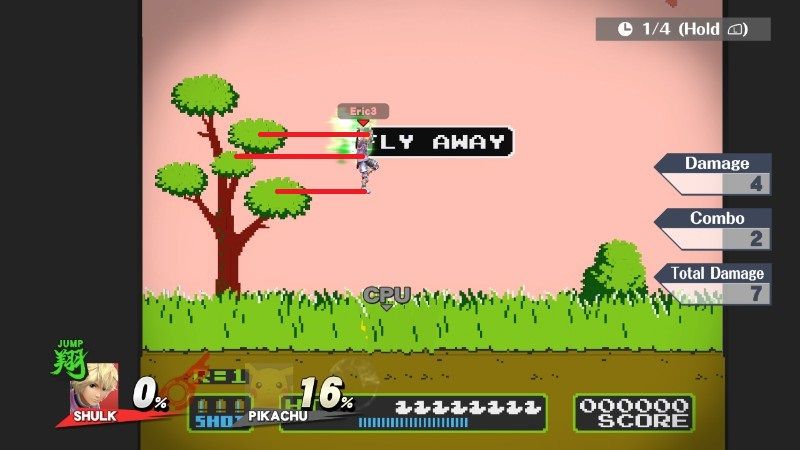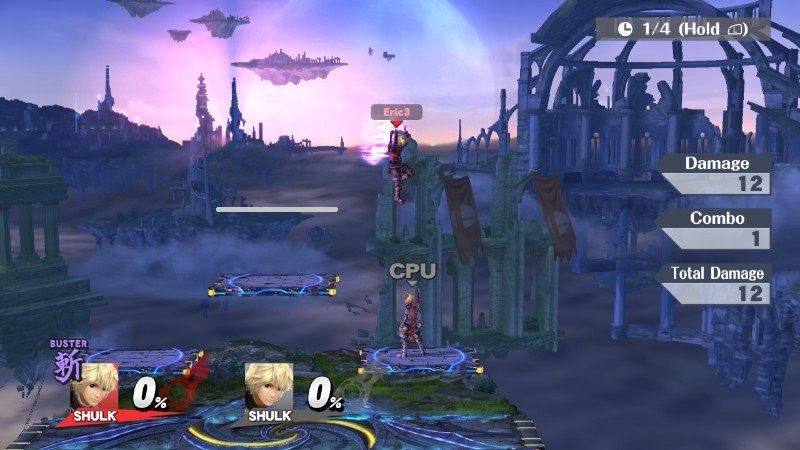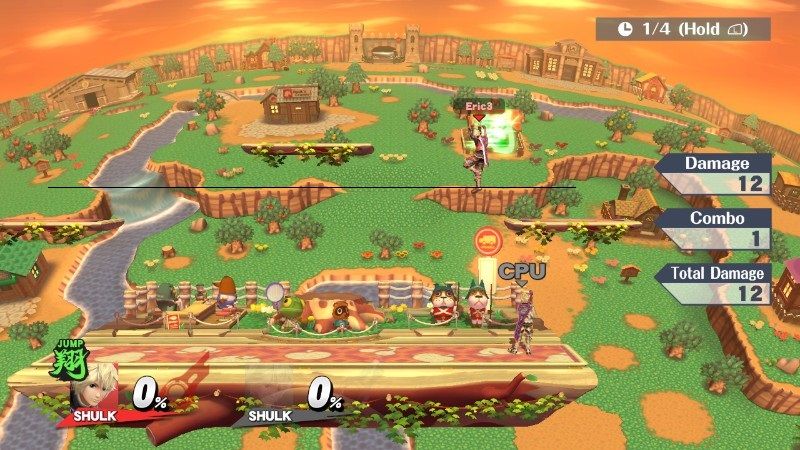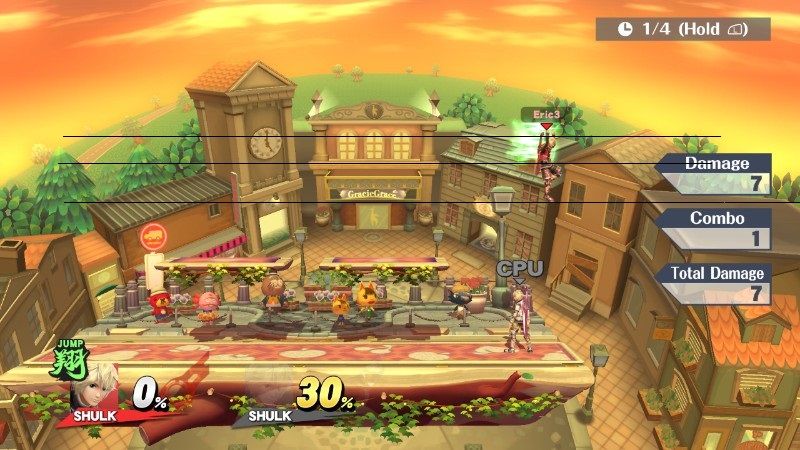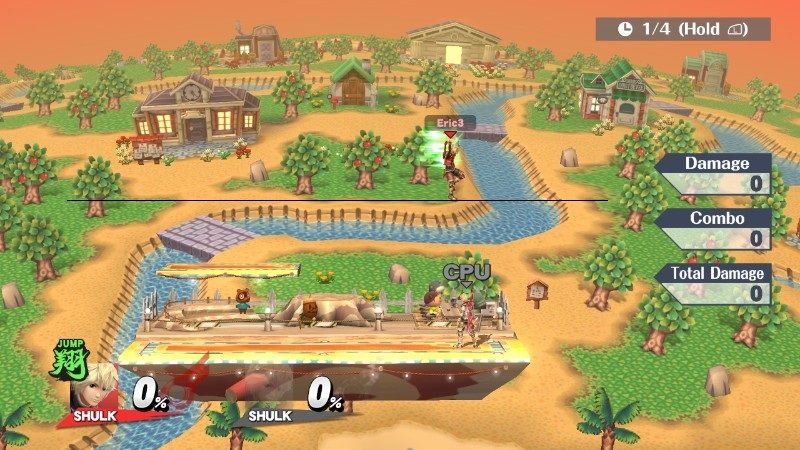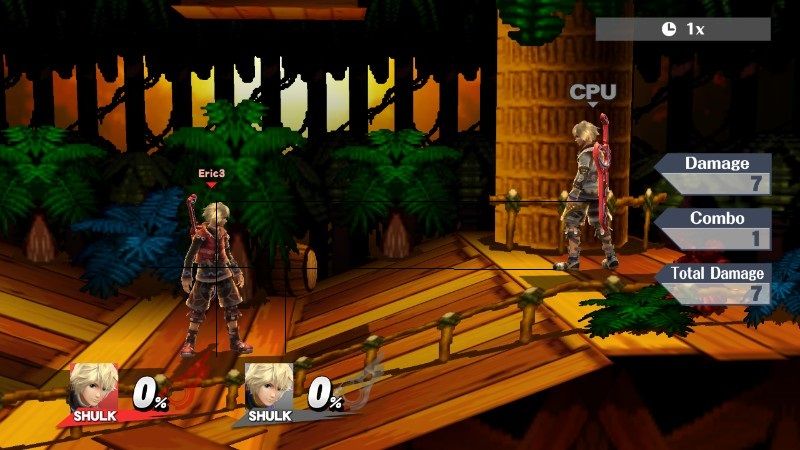Berserker.
:^)
- Joined
- Jun 8, 2009
- Messages
- 18,990
Shulk advanced techniques/tech thread
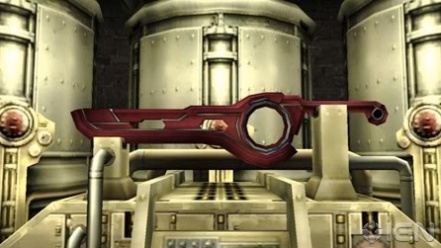
"I hope I can figure out the secret of its power one day"
Credit to @ Masonomace
for almost EVERYTHING in the OP
Masonomace
for almost EVERYTHING in the OP
***
MALLC (Monado Arts Landing Lag Cancel)
"I hope I can figure out the secret of its power one day"
Credit to @
***
How to perform it:
Prepare a Monado art activation
(Upon suffering landing lag from using an aerial, Art activates and cancels the landing lag)
Applications: This tech is extremely pivotal and important for Shulk for it effectively nullifies one of Shulk's primary weaknesses: His landing lag. This also allows him to throw out aerials and remain safe due to the cancelled landing lag making his rushdown/approach options safer than before. Spacing with this tech is the key to maximizing its usage. Using it up-close will likely get you to be beaten out before even pulling out the aerial. MALLC is most known for being used with b-air. B-air is one of Shulk's best moves because of it's insane horizontal reach, however one flaw of it is its landing lag being at 21 frames. MALLC can fix that which gives Shulk a fierce spacing option which can even be combo'd off from if you land a hit with it (dash grab in speed or f-smash or f-tilt depending on how far you are). One more nifty use of MALLC is to abuse the short intangibility of the monado art activation animations. The intangibility window varies from art to art, jump having the shortest duration.
MADC (Monado Art Dash Cancel)
How to perform it:
Prepare a Monado art activation
(Art activates which cancels the dash animation)
Applications: This tech is useful in certain situations. It's great for ledge trapping and maybe mixing-up your dash approaches. The issue with the latter is that this is MUCH more predictable and easy to anticipate than MALLC (or art cancelling in short). With MADC, you can perform techniques such as a sliding u-tilt, sliding f-smash, or a sliding d-smash. You can also use this such that pretty much your whole moveset (sans dash attack) is basically some sort of pseudo-dash attack. With the additional slide effect (which is most notable in shield, buster, and smash art), MADC or dash cancelling is great for juggles, ledge trapping and for landing kills
MABD (Monado Art Buffered Deactivation)
How to perform it:
Press
Applications: This tech is amazing for throw set-ups and combo extensions. You can use this along with MALLC/art cancelling to extend your combos. For example, from d-throw, you can buffer deactivation then combo with f-air after then art cancel into jump. You'd have enough time to throw out another attack on the opponent. You can also create some set-ups with MABD. For example, with buster d-throw. You can buffer the deactivation such that you can land KO's from the throw via air slash, or dash u-smash or b-air. This is also fairly useful with recovering since using this tech with jump art allow your jumps to be surprisingly higher than it is in jump art. So basically, MABD is amazing for enhancing Shulk's throw reward and it also opens new doors to longer combos and more reliable set-ups
Other notes (Credit to
MABD MSpeed JCUS|9 or 7 (-2 for jump crouch)
MABD MSpeed Walk|6.5
MSpeed JCUS|6.5 or 4.5 (-2 for jump crouch)
MSpeed Running Up Smash|6
MJump Landing|5.5
MSpeed Sliding Pivot|5
MARC|5
MSpeed Walk|4
Vanilla JCUS|3.5
MSpeed jump crouch|2
-MABD from Speed -> run -> jump cancelled up smash travels quite far. The jump cancel is needed here.
-MARC has an unexpectedly large slide distance
-Speed MARC travels the same distance unless the activation animation is interrupted
-MABD MSpeed Walk has a great slide distance
-MABD -> Buster D-Smash is nice because they can't unshield between the hits and get shield poked.[/QUOTE]
B-Reversing
In order to do a grounded B-reverse, you must be using a mixture of cycling arts while moving. If you're trying to learn how to B-Reverse on the ground, start with just cycling to Jump or whichever art & then start dashing to running in a direction. If you're holding your joystick towards a direction while dashing or running & you press the B button, you misinput it as Back Slash.
(Cycling arts while walking, dashing, running, or slow running to the
(Cycling arts while walking, dashing, running, or slow running to the
Misinput / Troubleshooting
If you end up getting a dash turn animation, it means you're tapping your joystick to the opposite direction too soon. You have to be patient & let the art activate first. The art flashing brightly for a brief moment is a good indicator to help your timing.
Moves that can be used while the slide from the grounded B-Reverse happens:
- Short Hopping or Full Hopping, Up tilt, uncharged Forward smash, uncharged or charging Up smash, uncharged or charging Down smash, Standing Grab, Shielding, Spot Dodge, Forward Roll, Back Roll, and Back Slash
- Jab, Forward tilt, Down tilt, charging Forward smash, Dash Grab, Pivot Grab, Air Slash, and Vision
Knowing the different slide distances
How fast you're moving varies with how far you side from the grounded B-Reverse. So in one scenario, Shulk is walking, & the other scenario is Shulk dashing to running. In the walking scenario, Shulk B-Reversing Up tilt will slide about a third of the distance the other Shulk would travel when running. Likewise, a Shulk that is running & B-Reverses Up tilt will slide farther across the floor than a Shulk who's slow running.
What to gather from this
B-Reversed Up tilt is great. If you cycle to Speed & then B-Reverse Up tilt connecting the Blade sweetspot, you instantly create the Speed walking Up tilt juggling or Up airs scenario. B-Reversing any smash attack is super neat to try as for an example, you can cycle to Buster & at the last moment dash away from your current position near the ledge to make your opponent think you're giving them breathing room, then you B-Reverse Dsmash toward the ledge & semi-charge it to deal huge damage to them on-hit or on-shield which potentially breaks it. Above all, imho, the best rewarding option to perform with the grounded B-Reversed is standing grab. When you talk about Vanilla Shulk's grab choices no matter which one, they're all mediocre at best. However, combine a standing grab option with the grounded B-Reverse & the slide you gain from a running motion, you get grab range greater than Vanilla dash grab & arguably Vanilla pivot grab. Perhaps Speed Art B-Reversing grab isn't as effective as Jump Shield Buster or Smash, but still, it's much better than standing grab or dash grab by themselves.
Airborne
In order to B-reverse in the air, you must be using a mixture of cycling arts while drifting. If you're trying to learn how to B-Reverse in the air, start by dashing to running across the ground & jump into the air. After that, release your joystick letting it sit back to neutral & cycle to Jump art. If you kept holding your joystick toward a direction to drift in the air & then tried to press B, that inputs as a Back Slash which is an unfortunate event off-stage. "Not good!"
Also, if you're tumbling in the air, you cannot input a B-Reverse. So either use an aerial or airdodge to stop tumbling. If you don't want to use an aerial or airdodge, then using doublejump instantly removes the tumble state.
(Cycling arts while drifting to the
(Cycling arts while drifting to the
Misinput / Troubleshooting
If you end up getting a turnaround, it means you tapped or held your joystick to the opposite direction much too soon. Like I said for the grounded B-Reverse, just be patient & let the art activate. The art flashing beside Shulk's character portrait is a good indicator to use for timing it better.
About the airborne B-Reverse
When you B-Reverse your art activation in the air, you shift your movement from one direction to the opposite. The distance you travel in the air during the B-Reverse is the same for all five Monado arts. Yes you read right. Jump, Speed, & Shield all drift the same air speed during the whole duration Shulk is performing his unique pose for said art. It's when Shulk finishes performing the unique pose & returns the Monado on his back that the art's mobility start to take effect. However, this is only when you do not interrupt the unique pose Shulk makes for said art. You can instantly gain the art's drift speed when you interrupt the unique pose. To do this, you can use either Doublejump, Neutral air, Forward air, Back air, Up air, Down air, or Airdodge. On the other hand, using Back Slash Air Slash or Vision don't grant the art's drift speed because Back Slash does its own thing, but Air Slash does get the vertical boost from Jump or the horizontal drift speed increase from Speed & decrease from Shield respectively. Vision is kinda like Shulk performing a pose during an art activation because the art's drift speed & mobility only starts taking effect after Vision's endlag finishes & Shulk returns the Monado on his back.
Applications: Mixups become very interesting. Shulk is a very special character in that he's the only character in the game that can act with any of his moves immediately after B-Reversing from the ground or the air respectively. Most characters that B-Reverse their Neutral B must cancel their action by either shielding or pressing the grab button to revert some sort of charging animation. For Shulk though, If you're first cycling arts & then dashing to running or drifting toward a direction followed by ceasing art cycling, you can time the B-Reverse after seeing the art flash beside Shulk's character portrait near the damage meter. This results with a movement slide toward the opposite direction. The B-Reverse by itself looks neat plus if it's an airborne B-Reverse by itself you still have the intangibility frame window for defensive frame protection. but add in a move & you create an option that no other character can perform with the sacrifice of losing the intangibility window. Some options include:
- Walking > Art B-Reverse Jab
- Dashing > Art B-Reverse Dtilt
- Running > Art B-Reverse Dsmash
- Jumping & drifting > Art B-Reverse Nair
- Jumping & drifting > Art B-Reverse Airdodge
- Art B-Reverse > Wavebounced Back Slash
And again, I seriously see potential in B-Reversed grab. According to Shulk's frame data, standing grab going by numbers is the safest option between standing grab, dash grab, & pivot grab, but standing grab by itself is the worst when it comes to an actual match when you want to go for a grab. So to make standing grab better, Art B-Reversing grab improves the standing grab option immensely. This effective option is worsened by the Speed art unfortunately, but eh still fine.
Pivoted Forward TiltHow to perform it:
(While Dashing or Running Left)
(While Dashing or Running Right)
As you're Dashing or Running towards a direction, tap to the opposite direction on the control stick & press the A button.
Applications: This technique is a swell spacing option for Shulk. Not only does Shulk hit characters from up close as he slides a bit of distance during the pivoted animation, but per-say a roll or any chasing approach coming toward you, this technique can be the solution to that. Pivoted Forward Tilt becomes a solid option for Speed Shulk since he slides a great amount of distance, & Buster Shulk's F-tilt deals amazing damage & shield knockback for when characters approach you with shielding after dashing or running towards you. Shield Shulk slides less distance than Vanilla but that can be utilized for closer fighting range. And if you're playing safe with Smash Shulk, this technique doesn't hurt you for trying it despite the weaker shield damage & shield knockback.
Jump Canceled Up Smash
How to perform it:
(Tap Jump on) While dashing or running
(Tap Jump off) While dashing or running
Applications: JCUS slightly extends the distance you travel across the ground rather than doing a hyphen smash or running USmash. The times you're dashing or running to a direction, getting that extra distance to assure USmash hits the opponent can be done with this technique. Shulk's 1st hit of USmash from the front reaches farther than from behind, & because Shulk still moves slightly forward while doing the JCUS, the 1st hit knocking them up into the 2nd hit is more guaranteed since the opponent could tap the control stick in order to DI away from the 2nd hit. Only the Speed & Shield Arts make a mobile difference to this technique, which Speed increases the distance & Shield decreases the distance (It's not even worth trying to JCUS with Shield Art on. You're better off doing running USmash or hyphen smashing out of a dash as Shield Shulk). Catch characters trying to land to the ground with this technique especially when you're Speed Shulk, & using it to catch a ledge option is not too shabby either.
Reverse Jump Canceled Up Smash
How to perform it:
While dashing or running left
While dashing or running right
Applications: The difference that you'd utilize about RJCUS compared to JCUS is the reversed motion since USmash's 1st hit from the front has a better hit-box range than behind the USmash. It'd be more common using this technique with only the Speed Art but Vanilla or rather any Art active still works. Reversing the JCUS will mess up an opponent's DI capability since they'll think to hold away, but this would actually favor the RJCUS because they'll be holding towards the direction they get launched to, being the USmash's 2nd hit. USmash in general can punish spotdodge or a ledge option like the ledge-roll, but a RJCUS would punish those same options including others such as a forward roll towards you in order to get behind you.
Neutral Air Landing
How to perform it:
Upon landing »
(If C-stick is set to Attack) Upon landing »
Applications: When performing an aerial out of a rising Full Hop with Vanilla Shulk such as FAir, BAir, or UAir, you can input NAir as you're about to land so that you land with only 12 frames of landing lag instead of 17 - 21 frames of landing lag. Shulk's NAir has the shortest amount of landing lag frames, so when you're trying to position yourself by falling to the ground after placing an aerial, it may be helpful landing with N-air & apply drifting in a direction based on the opponent's positioning & reaction to you Full Hopping. Jump Art expands the possibilities of this tactic not just because you're jumping around, but because Short Hopping or Full Hopping an aerial, & landing with NAir while drifting away from or towards your opponent causes Jump Shulk to slide a bit of distance towards across the floor. It's also notable that NAir starts from behind you & becomes active on frame 13, so a retreating NAir upon landing & facing away from your opponent can cover you at the last moment.
*Some Examples*
Jump Shulk
Short Hop » FAir » NAir landing lag
Full Hop » FAir » NAir hit-box & landing lag
Full Hop » BAir » NAir hit-box & landing lag
Full Hop » UAir » NAir landing lag
Full Hop » DAir » NAir landing lag
Speed Shulk
Short Hop » AirDodge » NAir landing lag
Full Hop » AirDodge » NAir hit-box & landing lag
Full Hop » FAir » NAir landing lag
Shield Shulk
Short Hop » AirDodge » NAir landing lag
Full Hop » FAir » NAir landing lag
Full Hop » AirDodge » NAir hit-box & landing lag
Vanilla Shulk, Buster Shulk, & Smash Shulk
Short Hop » AirDodge » NAir landing lag (It's unneeded but it can fake someone out since it looks like it's active)
Full Hop » FAir » NAir hit-box & landing lag
Full Hop » BAir » NAir landing lag
Full Hop » UAir » NAir landing lag (This is tricky because inputting UAir too quickly can become USmash)
Air Slash Out of Shield
How to perform it:
(Tap Jump on) Press & hold
(Tap Jump off) Press & hold
Applications: Moments where you block an attack or you just want to be safe sitting in shield & want to punish their mistake, Air Slash is for you. Whether you like to zone the ledge & shield a ledge-attack or any attack you foresee near the ledge like their recovery move, or even them ledge-dropping & double jumping with an aerial, you can act out of shield & punish the aerial's endlag or the landing lag. Any projectile(s) that's dropped to hit you from above can be blocked & then the rising 1st hit of Air Slash can scoop them up followed by the 2nd hit no problem. If needed, you can also reverse the Air Slash to hit from behind you in case someone rolls or ledge-rolls behind you.
Air Slash Recovering Horizontally
How to perform it:
(Recovering Left)
(Recovering Right)
Applications: Optimizing our recovery with Air Slash is vital & very helpful. Times you're launched out too far & need to inch closer horizontally with the 2nd hit of Air Slash is key for surviving longer. For a visual signal of when it's safe inputting the 2nd hit of Air Slash after enough time delaying it, watch the red Beam disappearing from the Monado as it's swung behind Shulk. Right as you see that happening, input the 2nd slash while holding toward the direction you're moving towards to maximize the horizontal distance of the Air Slash. This helpful tactic is further improved by the Jump & Speed Arts because of their respected increased mobility stats, & as you'd figure the Shield Art makes this worse, delaying the 2nd hit of Air Slash with Shield active can still save your stock because delaying the 2nd slash to move forward or backward in most cases is always better than not delaying it at all.
*Note* Whenever you're performing an Air Slash & per-say you get hit in the midst of the delayed 2nd hit of Air Slash by an attack near the ledge, then pressing the B button again while holding forward would input as Back Slash which is a huge no-no. Instead of pressing B, conditioning yourself by pressing the A button or flicking the C-stick would input as a F-air. And pressing the Z button inputs as Airdodge, which finishes quicker than F-air. Perhaps maybe players would think it's good to input Air Slash normally & instead press Z for the 2nd slash in hopes to avoid inputting a move that could be a dangerous risk to do.
Jump Canceled Vision
How to perform it:
(Tap Jump on) Either
(Tap Jump off) Press
Applications: A quickly executed Jump Canceled Vision in stationary position will travel a farther distance therefore extending the hit-box range of the Vision counterattack rather than a regular grounded Vision counter. Certain timing & height above the ground during the Vision counter is necessary for different results in order to extend the range of the attack even further, but again, a quickly executed JCV OoS with very little height off the ground is enough to be a noticeable result. The drawback to the JCV (which is jumping in the air & Vision countering in a way that Shulk's feet return to the ground before attacking) is that it loses the intangibility a grounded Vision possesses, which allows grounded Vision to counter most attacks like Flare Blitz & Metal Blade. If you were to attempt JCV countering Mega Man's Metal Blade with your intentions, then Shulk would be punished for it thus JCV is character-dependent against other MUs.
*Note* Jump Canceled Vision done airborne & landing on the ground before the counterattack begins does indeed increase the hit-box range of the move, but not touching the ground before the Vision counter sacrifices the intangibility it possesses. One way to counter an attack with JCV is by instantly canceling the jump so that Shulk's feet stay grounded before & after Vision counters the attack. You won't lose the intangibility from the Vision counter if done very quickly per-say out of shield or when dashing / running toward a direction.
Dashing / Running to Shield Grab
How to perform it:
While dashing or running to the
Applications: Dashing or Running to Shield Grab can be helpful for approaching against the opponent's landing option, considering that they may use one of their aerials to cover their landing. Dashing or Running in & Shielding the attack at the right moment will cause a perfect shield to their attack & punishing them by grabbing out of shield would defeat the opponent's option of trying to keep you out. This also helps if you manage to Dash / Run Shield into a Pivoted FTilt & answer it by quickly shield grabbing after the move finishes hitting your shield unless the FTilt deals enough shield knockback to push you away. In that case, a Monado Art would improve this because any Art active following into a successful grab leads to a throw, but what about those moves that deal good shield knockback? Speed Art would be your answer to that. Speed Shulk has higher traction therefore takes less shield knockback from attacks, allowing him to punish with shield grab much more easily than Vanilla or any other Art. The increased traction also means that the distance you slide across the floor while Dashing / Running to Shield Grab is shortened, granting better control with your shield grabbing. Since Speed Shulk moves quickly & travels great amounts of distance from Dashing or Running, it blends well with shortened sliding from holding shield during a moving option.
Combat Walking
How to perform it:
Hold the
Note: Monado Arts don't affect this technique's movement. However, it's best to use the Buster Art with this technique as you'll find yourself dealing a lot of damage with just Jab-1 repeatedly & it's less knockback than Jab-2. As long as you delay Jab-3 so that it's able to hit, or mix it up after Jab-1 like grab or a tilt, you'll be fine.
Last edited:



